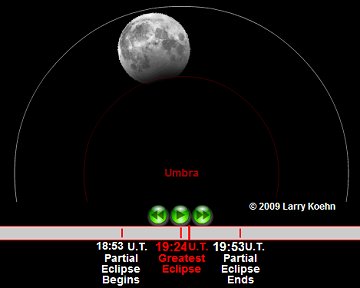Space Weather News for Dec. 31, 2009
BLUE MOON ECLIPSE: For the first time in almost 20 years, there’s going to be a "Blue Moon" on New Year’s Eve. In Europe, sky watchers will witness an even rarer event–an eclipse of a Blue Moon on New Year’s Eve. What are the odds? Probabilities and observing tips may be found at http://spaceweather.com.
A blue moon is the 2nd full moon in a calendar month.
From NASA we read this:
If you told a person in Shakespeare’s day that something happens "once in a Blue Moon" they would attach no astronomical meaning to the statement. Blue moon simply meant rare or absurd, like making a date for the Twelfth of Never. "But meaning is a slippery substance," says Hiscock. "The phrase ‘Blue Moon’ has been around for more than 400 years, and during that time its meaning has shifted."
The modern definition sprang up in the 1940s. In those days, the Farmer’s Almanac of Maine offered a definition of Blue Moon so convoluted that even professional astronomers struggled to understand it. It involved factors such as the ecclesiastical dates of Easter and Lent, and the timing of seasons according to the dynamical mean sun. Aiming to explain blue moons to the layman, Sky & Telescope published an article in 1946 entitled "Once in a Blue Moon." The author James Hugh Pruett cited the 1937 Maine almanac and opined that the "second [full moon] in a month, so I interpret it, is called Blue Moon."
That was not correct, but at least it could be understood. And thus the modern Blue Moon was born.
Blue moon has other connotations, too. In music, it’s often a symbol of melancholy. According to one Elvis tune, it means "without a love of my own." On the bright side, he croons in another song, a simple kiss can turn a Blue Moon pure gold.
On Dec. 31st, the Blue Moon will dip into Earth’s shadow for a partial lunar eclipse. The event is visible from Europe, Africa and Asia: map. At maximum eclipse, around 19:24 Universal Time, approximately 8% of the Moon will be darkly shadowed. Click on the image to launch an animated preview:
Blue Moons are rare (once every ~2.5 years). Blue Moons on New Year’s Eve are rarer still (once every ~19 years). How rare is a lunar eclipse of a Blue Moon on New Year’s Eve?
A search of NASA’s Five Millennium Catalogue of Lunar Eclipses provides an approximate answer. In the next 1000 years, Blue Moons on New Year’s Eve will be eclipsed only 11 times (once every ~91 years). So this is a rare event, indeed.
Very cool.



































Hmmm…maybe I ought to go out and buy that Powerball ticket tomorrow!
That’s really interesting – if our weather clears up I’ll head out to see it!
An interesting factoid: in 1999 there were two blue moons – in January and again in March. The lunar cycle missed a full moon in February. The previous double full moon year was in 1961, and the next one won’t be until 2018. I love geeky trivia like that!
A funny story: I was chatting with one of my students a few years ago and used the phrase “once in a blue moon.” She looked a bit confused, so I asked her if she knew what a “blue moon” was. Her reply: “Sure – it’s the kind of beer my dad drinks.”
Very neat!
“Elvis tune”? That line comes from “Blue Moon,” written by Rodgers and Hart and published in 1934. It is a standard of the Great American Songbook, and Elvis is just one of a long list of artists who have recorded it. (The Marcels did a rock-and-roll version that’s even more famous that Elvis’s, but for my money, no one has ever improved on Ella Fitzgerald’s rendering.)
(I’m not familiar with the “other song” that NASA refers to, but in the Rodgers and Hart piece, it took, not a kiss, but “somebody” whispering “please adore me” for “the moon [to] turn[] to gold.”)
OK, it’s visible right now over Scandinavia, a shaded area from 7 o’clock to 4 o’clock. The New Year’s Eve fireworks are far below!